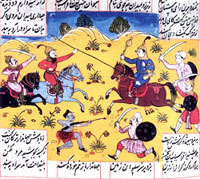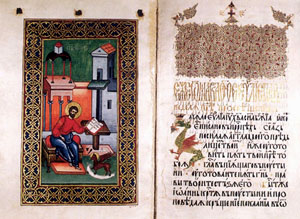|
|
|
|
|
|
From the very beginning,
the Romanian Literary Society’s primary
mission was to elaborate the three necessary
instruments of a modern culture, namely to
normalize the orthography, set down the
grammar, and compile an exhaustive
dictionary of the Romanian language. After
the transformation of the Society into the
Romanian Academy, these three basic
instruments remained the Academy’s
preeminent tasks. |
|

|
Ferdousi, Shah
Name (The Book of Kings),
a copy from
the 19th century.
Detail with a war scene
(Oriental ms. 333) |
|
|
The first academic
grammar, written by Timotei Cipariu, was
published in two volumes between 1859-1867
and received the Award of the Romanian
Academy. After many decades, it was replaced
by a collective work coordinated by Al.
Graur, Gramatica limbii române (Romanian
Grammar), published in two editions (1954
and 1963) and known as Gramatica Academiei
(the Academy’s Grammar). It has had an
immense importance to Romanian culture and
education: all Romanian language schoolbooks
were and still are based on it, as were and
still are university courses and grammatical
research. |
|
A year after the
foundation of the Romanian Literary Society,
the first project of an orthography was
presented. After lengthy debate, in 1881 the
modern orthography of the Romanian language
was adopted through the vote of the members
of the Academy, greatly influenced by that
of the distinguished philologist and
literary critic Titu Maiorescu. With only
minor reforms (in 1904, 1932, 1953 and
1991), the same orthographic norms are still
valid today. |
|
The academic Dictionar
(Dictionary) has a somewhat more involved
history. After A. T. Laurian and I. Massim
made a first attempt, publishing between
1871-1876 two volumes of a dictionary
unfortunately based on unrealistic
principles, the project was entrusted to
B.P.Hasdeu, truly a Renaissance man. He
published three volumes (letters A-B up to
the word barbat) of the celebrated
Etymologicum Magnum Romaniae (1887-1895), a
revolutionary academic dictionary which,
unlike other academic dictionaries, for
instance the French or Spanish ones, accepts
in principle any word of the respective
idiom. However, dissatisfied with the slow
pace at which such a dictionary could only
progress, the Academy made a third attempt
with Alexandru Philippide, Professor at the
University of Iasi and founder of an eminent
school of philology. Since he proved also
unable to meet the scheduled deadlines, the
Academy called upon Sextil Puscariu,
professor in Cluj, who, with only a small
group of specialists, succeeded in
publishing letters A-L of the dictionary
between 1906-1944. Thus a fundamental work
was achieved, which could be regarded as the
most scientific academic dictionary in the
world. After 1949, the Academy continued
this endeavor with three large teams
comprised of researchers from the three
institutes of linguistics in Bucharest, Cluj
and Iasi and headed by Academicians Iorgu
Iordan, Al. Graur and I.Coteanu as
Editors-in-Chief. Since 1998, the
Editors-in-Chief have been Marius Sala and
Gh. Mihaila, Associate Members of the
Academy. Up to the present, the letters M-T
and partially V have been published, while
letters D, E, U, V, X-Z are compiled for the
most part. In the end, the dictionary will
include at least 150,000 words and lexical
variants. |
| We may conclude that at the beginning of
the third millenium, all three linguistic
instruments have been perfected. |
|
In addition to these
fundamental works, we must also mention
Atlasul lingvistic român (The Romanian
Linguistic Atlas) by Sever Pop and Emil
Petrovici, ALR I (2published volumes) and
ALR II (8 volumes) both realized in Cluj.
Regional linguistic atlases have also been
drawn up, 20 volumes of which have been
published so far, covering the regions of
Oltenia, Muntenia and Dobrogea,
Transilvania, Banat, Crisana, Maramures and
Moldova. Under the guidance of Al. Rosetti,
a group of linguists undertook the research
of the history of the Romanian language,
finalized in a treatise of which two volumes
were published (1965-1969). |
|
Manuscript
of the Gospels from the
Caldarusani Monastery, 1643.
The beginning of the Gospel of
St. Mark (Slavic ms. 13) |

|
|
|
At the Institute of
Linguistics Iorgu Iordan in Bucharest, other
lexicographic works have been completed,
such as Dictionarul limbii române moderne
(Modern Romanian Dictionary),1958,
Dictionarul explicativ al limbii române
(Explicative Romanian Dictionary) published
in two editions in 1975 and 1996, with a
total print run of 560,000 copies, two very
rich bilingual dictionaries, Dictionar
german-român (German-Romanian Dictionary)
and Dictionar englez-român (English-Romanian
Dictionary), Dictionarul toponimic al
României I Oltenia A-D (Romanian Toponimic
Dictionary I Oltenia A-D) published between
1993-1995, and Dictionarul limbii poetice a
lui Eminescu (Dictionary of Eminescu’s
Poetic Language), 1968. Micul dictionar
academic (the Concise Academic Dictionary),
a synthesis of the 32 volumes of the
academic dictionary, as well as Dictionarul
etimologic al limbii române (the Dictionary
of Romanian Etymology) and Noul dictionar
explicativ al limbii române (the New
Explicative Romanian Dictionary) are
currently under way. |
|
In the field of grammar,
there have also been Limba româna (The
Romanian Language), a work known as "the
one-volume grammar," published in 1956 and,
between 1970-1989, three volumes of a
treatise on word-formation in Romanian, with
Al. Graur and Mioara Avram as
Editors-in-Chief. A reference work is
Dictionarul ortografic, ortoepic si
morfologic al limbii române (the Dictionary
of Romanian Orthography, Orthoepy and
Morphology) of 1982. Ion Ghetie has
conducted a great number of works
researching the history of the Romanian
literary language. The latest, a collective
work of synthesis, Istoria limbii române
literare. Epoca veche 1532-1780 (History of
the Literary Romanian Language. The Old
Epoch 1532-1780) appeared in 1997. |
|
The Romanian school of
linguistics founded and headed by Iorgu
Iordan has contributed the following works:
Crestomatia romanica (Chrestomathy of the
Romance Languages), 5 volumes totaling over
6,000 pages, Vocabularul reprezentativ al
limbilor romanice (Representative Vocabulary
of the Romance Languages) in 1988, and
Enciclopedia limbilor romanice
(Encyclopaedia of the Romance Languages) in
1989, coordinated by Marius Sala. In the
field of American Spanish linguistics, the
work El léxico indígena del español
americano. Apreciaciones sobre su vitalidad,
1977, by Marius Sala, Dan Munteanu, Valeria
Neagu and Tudora Sandru-Olteanu obtained the
award of the Mexican Centenary at an
international competition. Another work by
the same authors, El español de America. I
Léxico, 2 vols., has been published by the
largest institute of linguistics in Latin
America (Bogotà, 1982). Both are reference
works in the domain of hispanic language
studies. |
|
Research in linguistics
is being undertaken, outside of the two
already-mentioned Bucharest institutions, in
Cluj-Napoca at the Institute of Linguistics
and Literary History Sextil Puscariu, in
Iasi at the Alexandru Philippide Institute
of Romanian Philology, in Timisoara at the
Titu Maiorescu Institute of Socio-Human
Reasearch, in Craiova at the
C.S.Nicolaescu-Plopsor Institute of
Socio-Human Research and at the Institute of
Socio-Human Research in Sibiu. |
|
These institutes
collaborate in large international projects
such as the Linguistic Atlas of Europe, the
Romance Linguistic Atlas, Patronymica
Romanica, the project PRACTEAST within the
Copernicus program of the European
Commission, etc. They have perfected accords
with similar institutes from abroad:
Institut National de la Langue Française,
Paris-Nancy, University of Anvers, and the
academic institutes of Bulgaria and Ukraine. |
|
Publication of academic
periodicals in linguistics began after 1940.
The most important are: Langue et
littérature, Studii si cercetari lingvistice
(Linguistic Studies and Research), Revue
(roumaine) de linguistique, Fonetica si
dialectologie (Phonetics and Dialectology),
Cahiers de linguistique théorique et
appliquée and others. In addition, there
have been miscellaneous series of volumes,
published non-periodically, specialized in
various branches of linguistics: grammar,
word-formation, literary language,
dialectology, onomastic studies, Slavic
studies, general linguistics. |
|
To the already-mentioned
eminent scholars, Members or Associate
Members of the Romanian Academy, we must add
the names of foreign scholars who, in time,
have been elected Honorary Members or
Associate Members: Manuel Alvar,
Graziado-Isaia Ascoli, Matteo Bartoli, Viggo
Brödal, Eugenio Coseriu, Giacomo Devoto,
Friedrich-Christian Diez, Theodor Frings,
Emil Gamillscheg, Moses Gaster, Jules
Gilliéron, Karl Jaberg, Vatroslav Jagic´,
Norbert Jokl, Alf Lombard, Antoine Meillet,
Ramon Menéndez Pidal, Wilhelm Meyer-Lübke,
Franz von Miklosich, Angelo Monteverdi,
Kristian Sandfeld-Jensen, Hugo Schuchardt,
Petar Skok, Leo Spitzer, Carlo Tagliavini,
Hayman Tiktin, Adolf Tobler, Viktor V.
Vinogradov, Walter von Wartburg, Gustav
Weigand. Their names illustrate the extent
and quality of Romanian academic
relationships in the domain of linguistics. |
| |
| |
| |
|
|
|
|